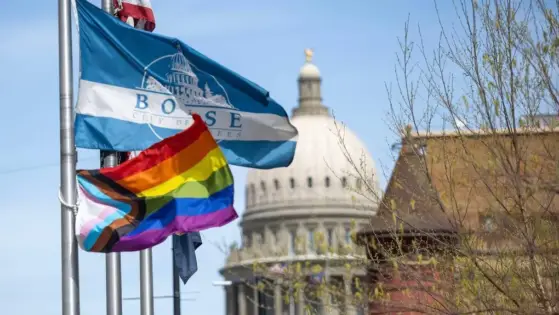Marijuana Expert Hates California’s Legalization Because It Will Make Weed Too Cheap
Mark A. R. Kleiman, a man whose first name is also his initials, is an esteemed public policy professor who thinks California’s Adult Use of Marijuana Act is a “horrible, awful, very bad, no-good drug policy” that is “Promoting cannabis use disorder in California”.
How’s that? Because legalization, California-style, he intones, would see prices “settle down at something below $1 per gram…” Yes, he means that like it’s a bad thing.
According to Kleiman, legal weed will be so cheap that people who like to smoke weed will smoke more of it more often. “In 1992, about 10% of people who reported using cannabis the past month reported having used it on 25 or more days that month,” Kleiman writes. “That number is up to 40%.”
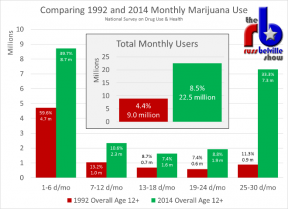 I’m not sure where Kleiman got his numbers, so I went and looked them up for myself in the National Survey on Drug Use and Health. There’s a variable called MJDAY30A that tells us, in both raw numbers and by percentage, how many days in the past thirty days a monthly toker has used marijuana.
I’m not sure where Kleiman got his numbers, so I went and looked them up for myself in the National Survey on Drug Use and Health. There’s a variable called MJDAY30A that tells us, in both raw numbers and by percentage, how many days in the past thirty days a monthly toker has used marijuana.
Indeed, Kleiman is right about the shift in daily use, even if my numbers are different. In 1992, just 11 percent of monthly tokers were in the top quintile (25 days or more per month), while in 2014, a full third of monthly tokers were near-daily tokers.
There are also just more of us monthly tokers. In 1992, 4.4 percent of the population was lighting up monthly compared to 8.5 percent in 2014[1]. Add in population growth and we’ve got two-and-a-half times the number of monthly tokers and we’ve got eight times the number of near-daily tokers.
But what has been the societal harm from this explosion in near-daily toking over the past two decades? Crime rates are at historic lows. Vehicle fatalities are at historic lows. Worker productivity is at an all-time high. High school graduation rates are at an all-time high. Teen drug use is in decline. What terrible thing has happened because of all this pot smoking?
According to Kleiman, the result has been an increase in this “cannabis use disorder”, which to him apparently means “people using cannabis often”. “Of those daily/near-daily users, about half – by their own self-report – meet diagnostic criteria for cannabis use disorder,” he writes. “Just over 4 million residents of the U.S. currently report meeting those criteria.”
Cannabis Use Disorder – a.k.a. Regularly Smoking Pot
Kleiman alleges that four million people have cannabis use disorder out of 22.5 million who are consuming it monthly. That means about 1 in 6 pot smokers supposedly have this so-called disorder. According to the DSM-V (the psychiatric manual), if a pot smoker meets two or more of these criteria, there can be a diagnosis of cannabis use disorder:
Right off the bat, if you’re a monthly cannabis consumer in a prohibition state, you’re going to check off #3 because of the time it takes to make a black market hookup. You’ll check #8 because your imminent arrest makes every place “high risk”.
The continued practice of urine screening at work and school creates the conditions to check off #5, not necessarily whether pot has affected productivity or education. Those legal and social pressures create unnecessary drama and ostracizing that lead to checking off #6 and #7.
If you’re a regular cannabis consumer, #1 and #10 are natural byproducts of use and #2, #3, #4, and #11 are natural reactions to abruptly ceasing use. Only #9 stands as a consistent reason to think someone’s regular cannabis use is a disorder.
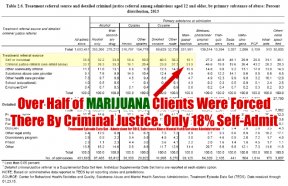 This over-diagnosis of regular cannabis consumers as being “disordered” is reflected in the statistics regarding cannabis rehab. According to the Treatment Episode Data Set-Admissions (TEDS-A) for 2013, well over half the people admitted with a primary diagnosis of cannabis use disorder were forced into treatment by the criminal justice system.
This over-diagnosis of regular cannabis consumers as being “disordered” is reflected in the statistics regarding cannabis rehab. According to the Treatment Episode Data Set-Admissions (TEDS-A) for 2013, well over half the people admitted with a primary diagnosis of cannabis use disorder were forced into treatment by the criminal justice system.
Only about 18 percent of marijuana users – less than one-fifth – admit themselves. Compare that to over a quarter of meth users, one-third of the drinkers, two-fifths of crack users, and over half the opiate users who feel they’ve got a problem enough to go to rehab for.
This is not to say there aren’t people with a serious problem with pot. But knowing how many there are is seriously confounded by the prohibition of marijuana in most states and the continued discrimination against marijuana consumers in the legal and medical states.
How M.A.R.K. Resembles U.S.S.R.
Here’s Mark Kleiman’s ideal system for marijuana sales from a 2014 interview in the Washington Post regarding his company’s consultation on Washington State’s legal marijuana policies, which he also says he’d apply to alcohol if he could, but that “we lost that battle”:
“If you want to buy one of those commodities, you should sign up as a buyer, you should probably take some kind of minimal test like a driving test to make sure you know what you’re talking about and then you should be asked to set for yourself a purchase quote on, say, a monthly basis. How many joint-equivalents a month do you want to use? Give us a number. Every time you make a purchase, that purchase will be recorded against that quota. And if you bought as much this month as you said you wanted to be able to buy this month, the clerk will say ‘I’m sorry the order was refused.’ Just what happens when you go over your credit card limit. It’s the same principle.”
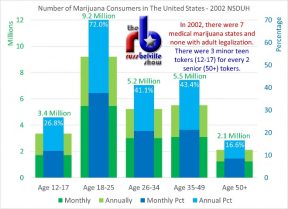 Just imagine trying to require adults to register with the state as drinkers, take a drinking awareness test, and then set for themselves a monthly quota of how many drinks they could purchase. And that a beer costs $20. That’s Mark Kleiman’s vision.
Just imagine trying to require adults to register with the state as drinkers, take a drinking awareness test, and then set for themselves a monthly quota of how many drinks they could purchase. And that a beer costs $20. That’s Mark Kleiman’s vision.
Kleiman is playing this up to feed the bogeyman that is “Big Marijuana”; the notion that cannabis is going to become a predatory industry like alcohol and tobacco, lying about harms and seducing the children.
Yet both those industries show us exactly why commercialized marijuana with low taxation is preferable to the maintenance of artificially high marijuana prices.
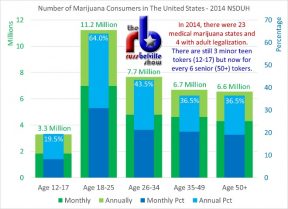 In states like Washington, there have been excessive taxes placed on cigarettes than have led to an extensive black market. In New York, this led to the death of Eric Garner, choked out by NYPD as they policed the area for sales of “loosies” – individual cigarettes sold to avoid high taxes. And we all remember the lessons of alcohol prohibition and its effect on gang violence.
In states like Washington, there have been excessive taxes placed on cigarettes than have led to an extensive black market. In New York, this led to the death of Eric Garner, choked out by NYPD as they policed the area for sales of “loosies” – individual cigarettes sold to avoid high taxes. And we all remember the lessons of alcohol prohibition and its effect on gang violence.
Yes, alcohol and tobacco went too far in marketing to kids and denying health risks, and we addressed those problems with lawsuits and new laws. Why would we then let cannabis have free rein to do the same? Already the laws concerning cannabis advertising, marketing, and retailing are far more restrictive than those for alcohol and tobacco because we learned those lessons.
Furthermore, alcohol and tobacco had to lie about their harms and entice kids to use them because they are harmful and taste terrible. Adults don’t take up cigarettes because they cough and stink and peer pressure won’t convince them to stick with it. Yet despite both these products being legally sold through heavily commercialized markets, teen smoking and drinking are at their lowest recorded levels ever and adult smoking and drinking are declining.
Since 2002, the absolute number of teenage marijuana consumers has declined. As marijuana has become more medicalized and legalized, it’s the consumption among adults that has increased. Most notably, in the 2014 National Survey on Drug Use & Health we find a tripling in the number of people aged 50 and older who are consuming cannabis.
Why Cheap Marijuana Is a Good Thing
Kleiman doesn’t like the commercialization of marijuana, because then it becomes too cheap and easy for people to use it more often. Even though the majority (5 out of 6, by his own estimation) of monthly cannabis consumers manage to avoid this disorder, Kleiman prefers some sort of system where California could “manage the quantity produced”, “limit the amount of cannabis [consumers could] be sold in the course of a month”, and require warning labels “mentioning the risk of cannabis use disorder”.
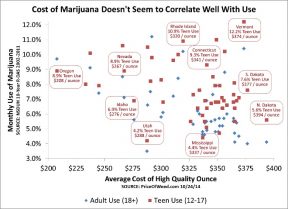 In short, Kleiman wants to keep the price of marijuana high enough to make it inconvenient for you to use it. “I would have had price as an explicit target of policy,” Kleiman said in that 2014 interview. “I would strongly argue that preventing a price drop is a major policy objective.”
In short, Kleiman wants to keep the price of marijuana high enough to make it inconvenient for you to use it. “I would have had price as an explicit target of policy,” Kleiman said in that 2014 interview. “I would strongly argue that preventing a price drop is a major policy objective.”
To Kleiman, preventing more people from using marijuana and curbing more use of marijuana by those already using it is the key objective, and that’s achieved by keeping the price artificially high. The problem is that an artificially high price for marijuana means subsidizing a black market for marijuana.
What frightens you more – that a pot smoker may smoke more legal, taxed, inspected pot or that a pot dealer keeps profiting from illegal, untaxed, contaminated pot?
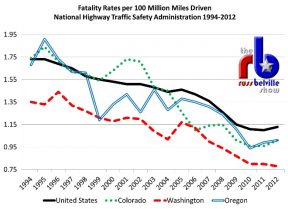 If California really gets the price of marijuana down to $1 per gram, maintaining any sort of black market dealing is going to be as tough as trying to sell home brewed beer on the streets.
If California really gets the price of marijuana down to $1 per gram, maintaining any sort of black market dealing is going to be as tough as trying to sell home brewed beer on the streets.
Kleiman also looks at the increase in near-daily pot smokers without considering other related benefits. How many of those regular monthly consumers are the newly-legal medical marijuana patients? We’ve seen decreases in opioid overdoses, suicide rates, traffic fatalities, and use of other drugs and alcohol when states increase access to cannabis.
Yes, I suppose it’s likely that $1 gram cannabis means the guy who’s got a problem with it is going to have a tougher row to hoe. As a person in recovery for obesity, I feel that pain every time I drive by the plethora of fast food restaurants with “dollar menus”. I’m sure life would be easier for the alcoholics if we closed all the bars, too.
How Wrong Do You Have to Be to No Longer Be a Marijuana Expert?
 It’s a wonder anyone consults with Mark Kleiman on marijuana policy. In 2010, as California was fixing to vote on Prop 19, he told the LA Times that, “There’s one problem with legalizing, taxing and regulating cannabis at the state level: It can’t be done… any grower or seller… would be confessing, in writing, to multiple federal crimes. And that won’t happen.”
It’s a wonder anyone consults with Mark Kleiman on marijuana policy. In 2010, as California was fixing to vote on Prop 19, he told the LA Times that, “There’s one problem with legalizing, taxing and regulating cannabis at the state level: It can’t be done… any grower or seller… would be confessing, in writing, to multiple federal crimes. And that won’t happen.”
Two years after saying that state-legal pot producers and sellers wouldn’t risk federal conspiracies, Kleiman and his company BOTEC were accepting a contract from Washington State taxpayers to consult on how to construct their state-legal system of pot producers and sellers risking federal conspiracies.
There in Washington Kleiman’s Soviet-style central economic planning led to chaos. Kleiman’s BOTEC recommended a state-limited production canopy and a limit on statewide retail outlets. The result was prices in Washington that were initially around $30 per gram and kept a flourishing black market so emboldened that dealers would sit in the legal pot shop parking lots and poach customers who wished to avoid the high taxes.
Now Washington State has enacted Senate Bill 5052, further elaborating on BOTEC’s policy prescriptions by shutting down the medical marijuana market and folding it into the recreational system. Thus, a city like Tacoma that had 70 outlets serving its marijuana market is now mandated to only have 16 outlets. So just as market forces had finally brought Washington’s weed price to under $10 a gram, Washington is going to restrict supply and raise those prices in the legal market while returning many medical marijuana patients to the black market.
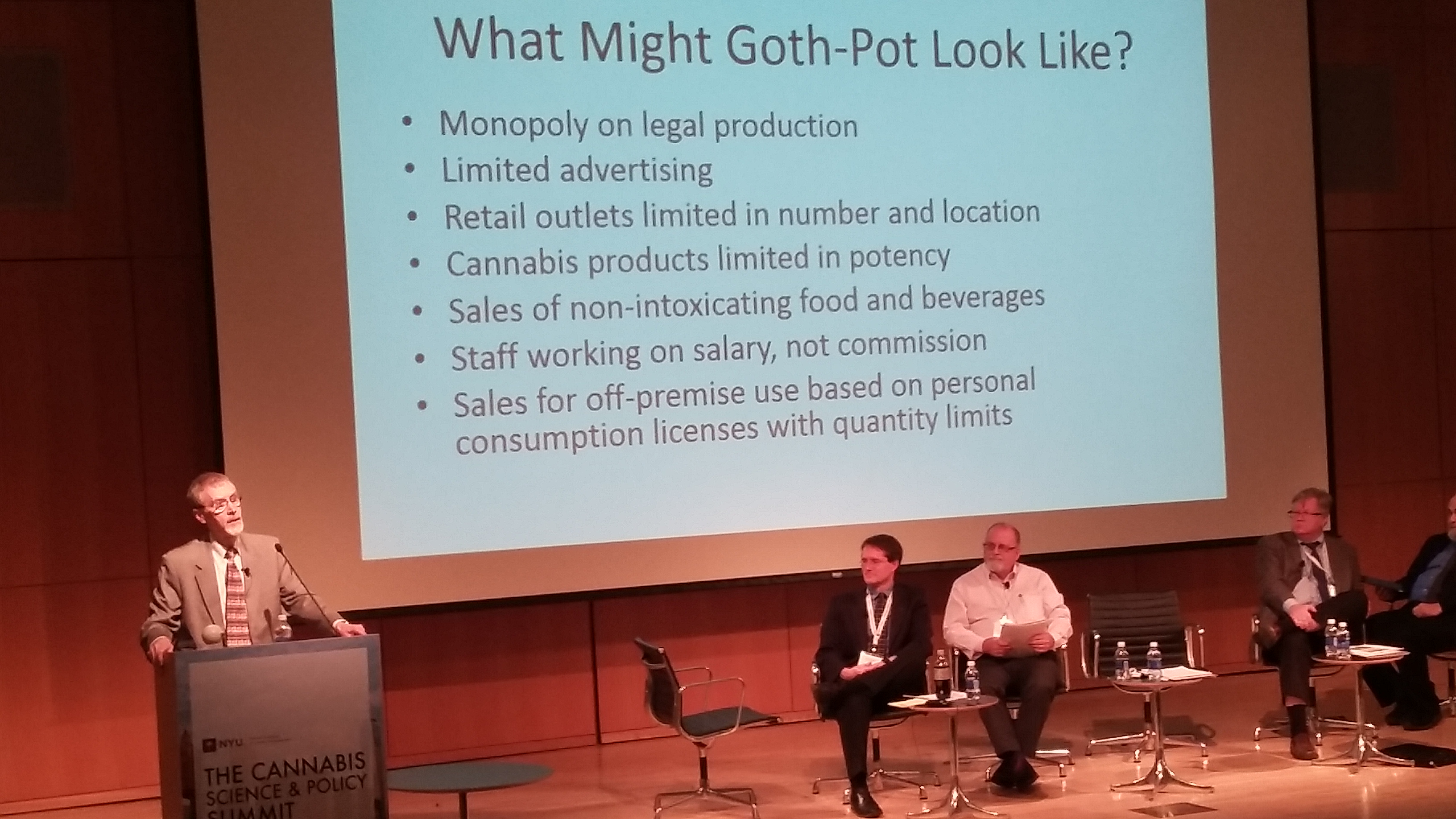
“If someone wanted to write a law to increase the prevalence of [cannabis use disorder], it would look a lot like the Adult Use of Marijuana Act,” Kleiman predicts. “That leaves the voters with a choice between the existing unworkable quasi-legalization in the form of a corrupt ‘medical marijuana’ system and a formal legalization designed to make the drug problem worse. I’m glad I left.”
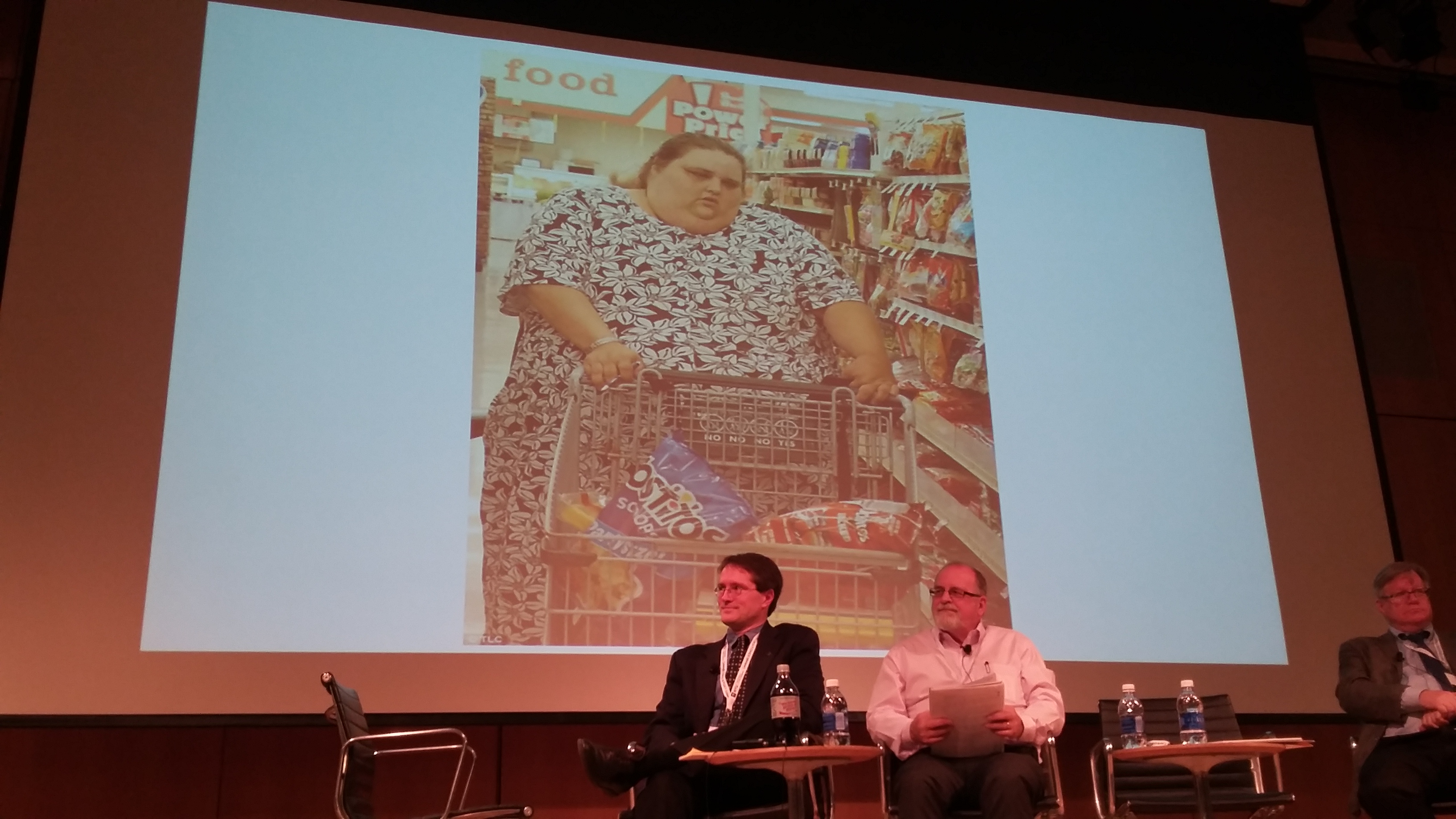
And if someone wanted to write a law to protect the black market, if would look a lot like the Washington law BOTEC helped craft, with no allowance for home growing, artificially restricted production and distribution, and the nation’s highest marijuana taxes.
I believe that many of the cannabis consumers in Washington State are wishing Kleiman had left much earlier. And you can bet that once California passes legalization, Kleiman, formerly a professor at UCLA, will be lining BOTEC up to apply for lucrative consultation contracts in the Golden State, arguing for ways to ensure cannabis consumers don’t get “wrecked out of their gourds” on cheap marijuana.
Don’t buy Kleiman’s rent-seeking hype. The benefits of cheap marijuana – including fewer illegal dealers, overdoses, suicides, and crashes – are worth the tiny minority of tokers who will end up smoking too much weed. Plus, they’ll save enough money on their habit they can better afford to self-admit to rehab, which will be less stigmatized and potentially funded by marijuana taxes. The only thing a free market in legal marijuana is a danger to is the consulting business of public policy wonks.
The variable for overall monthly tokers is MRJMON and for reasons that escape me, it’s total of monthly tokers differs from the total you get adding up MJDAY30A. ↑

